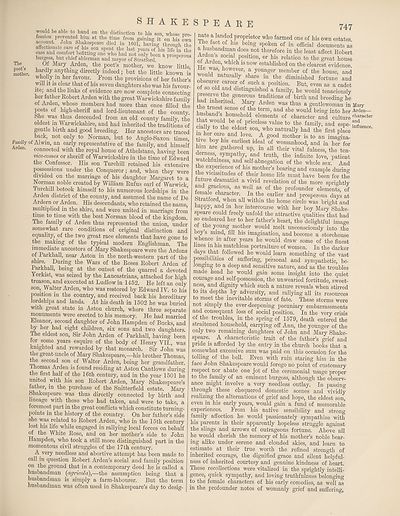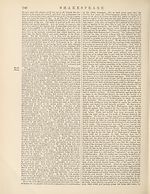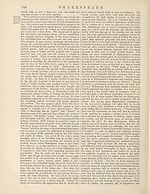Encyclopaedia Britannica > Volume 21, ROT-Siam
(757) Page 747
Download files
Complete book:
Individual page:
Thumbnail gallery: Grid view | List view

SHAKESPEARE
would be able to hand on the distinction to bis son, whose pro¬
fession prevented him at the time from gaining it on his own
account. John Shakespeare died in 1601, having through the
affectionate care of his son spent the last years of his life in the
ease and comfort befitting one who had not only been a prosperous
burgess, but chief alderman and mayor of Stratford. *
nMt’s u MaiT Arden, the poet’s mother, we know little,
mother. hfd 7 any^mg directly indeed; but the little known is
wholly in her favour. . From the provisions of her father’s
will it is clear that of his seven daughters she was his favour¬
ite; and the links of evidence are now complete connecting
her father Robert Arden with the great Warwickshire family
of Arden, whose members had more than once filled the
posts of high-sheriff and lord-lieutenant of the county.
She was thus descended from an old county family the
oldest in Warwickshire, and had inherited the traditions of
gentle birth and good breeding. Her ancestors are traced
back, not only to Herman, but to Anglo-Saxon times,
Family of A1 win, an early representative of the family, and himself
Arcieu. connected with the royal house of Athelstane, having been
mce-comes or sheriff of Warwickshire in the time of Edward
the Confessor. His son Turchill retained his extensive
possessions under the Conqueror; and, when they were
divided on the marriage of his daughter Margaret to a
Norman noble created by William Rufus earl of Warwick,
Turchill betook himself to his numerous lordships in the
Arden district of the county, and assumed the name of He
Ardern or Arden. His descendants, who retained the name,
multiplied in the shire, and were united in marriage from
time to time with the best Norman blood of the kingdom.
The family of Arden thus represented the union, under
somewhat rare conditions of original distinction and
equality, of the two great race elements that have gone to
the making of the typical modern Englishman. The
immediate ancestors of Mary Shakespeare were the Ardens
of Parkhall, near Aston in the north-western part of the
shire. During the Wars of the Roses Robert Arden of
1 arkhall, being at the outset of the quarrel a devoted
Yorkist, was seized by the Lancastrians, attached for high
treason, and executed at Ludlow in 1452. He left an only
son, Walter Arden, who was restored by Edward IV. to his
position in the country, and received back his hereditary
lordships and lands. At his death in 1502 he was buried
with great state in Aston church, where three separate
monuments were erected to his memory. He had married
Eleanor, second daughter of John Hampden of Bucks, and
by her had eight children, six sons and two daughters.
The eldest son, Sir John Arden of Parkhall, having been
for some years esquire of the body of Henry VII., was
knighted and rewarded by that monarch. Sir John was
the great-uncle of Mary Shakespeare,—his brother Thomas,
the second son. of Walter Arden, being her grandfather.
Thomas Arden is found residing at Aston Cantlowe during
the first half of the 16th century, and in the year 1501 he
united with his son Robert Arden, Mary Shakespeare’s
father, in the purchase of the Snitterfield estate. Mary
Shakespeare was thus directly connected by birth and
lineage with those who had taken, and were to take, a
foremost part in the great conflicts which constitute turning-
points in the history of the country. On her father’s side
she was related to Robert Arden, who in the 15 th century
lost his life while engaged in rallying local forces on behalf
of the White Rose, and on her mother’s side to John
Hampden, who took a still more distinguished part in the
momentous civil struggles of the 17th century.
A very needless and abortive attempt has been made to
call in question Robert Arden’s social and family position
on the ground that in a contemporary deed he is called a
husbandman (agricola),—the assumption being that a
husbandman is simply a farm-labourer. But the term
husbandman was often used in Shakespeare’s day to desig-
747
nate a landed proprietor who farmed one of his own estates,
ihe fact of his being spoken of in official documents as
a husbandman does not therefore in the least affect Robert
Ardens social position, or his relation to the great house
r en, w ich is now established on the clearest evidence
He was, however, a younger member of the house, and
would naturally share in the diminished fortune and
o0fb“ Car,ee,r. °,f suc.ha Portion. But, even as a cadet
so old and distinguished a family, he would tenaciously
preserve the generous traditions of birth and breeding he
tho tr!1 1 6 ' */airy Arden was thus a gentlewoman in Mary
the truest sense of the term, and she would bring into her Arden—
husbands household elements of character and culture char^cter
that would be of priceless value to the family, and esne- anfld
cially to the eldest son, who naturally had the first placelnfluence-
m her care and leva A good mother is to an imagina¬
tive boy his earliest ideal of womanhood, and in her for
im are gathered up, in all their vital fulness, the ten-
Sympatl!y’ anc! trutll> the infinAe love, patient
watchfulness, and self-abnegation of the whole sex. And
e experience of his mother’s bearing and example during
the vicissitudes of their home life must have been for the
future dramatist a vivid revelation of the more sprightly
and gracious, as well as of the profounder elements, of
female character In the earlier and prosperous days at
btratford, when all within the home circle was bright and
naPPy, and in her intercourse with her boy Mary Shake¬
speare could freely unfold the attractive qualities that had
so endeared her to her father’s heart, the delightful image
of the young mother would melt unconsciously into the
boy s mind, fill his imagination, and become a storehouse
whence in after years he would draw some of the finest
lines in his matchless portraiture of women. In the darker
days that followed he would learn something of the vast
possibilities of suffering, personal and sympathetic, be¬
longing to a deep and sensitive nature, and as the troubles
made head he would gain some insight into the quiet
courage and self-possession, the unwearied fortitude, sweet¬
ness, and dignity which such a nature reveals when stirred
to its depths by adversity, and rallying all its resources
to meet the inevitable storms of fate. These storms were
not simply the ever-deepening pecuniary embarrassments
and consequent loss of social position. In the very crisis
of the troubles, in the spring of 1579, death entered the
straitened household, carrying off Ann, the younger of the
only two remaining daughters of John and Mary Shake¬
speare. A characteristic trait of the father’s grief and
pride is afforded. by the entry in the church books that a
somewhat excessive sum was paid on this occasion for the
toiling of the bell. Even with ruin staring him in the
face John Shakespeare would forego no point of customary
respect nor abate one jot of the ceremonial usage proper
to the family of an eminent burgess, although the observ¬
ance might involve a very needless outlay. In passing
through these chequered domestic scenes and vividly
realizing the alternations of grief and hope, the eldest son,
even in his early years, would gain a fund of memorable
experiences. . From his native sensibility and strong
family affection he would passionately sympathize with
his parents in their apparently hopeless struggle against
the slings and. arrows of outrageous fortune. Above all
he would cherish the memory of his mother’s noble bear¬
ing alike under serene and clouded skies, and learn to
estimate at their true worth the refined strength of
inherited courage, the dignified grace and silent helpful¬
ness of inherited courtesy and genuine kindness of heart.
These recollections were vitalized in the sprightly intelli¬
gence, quick sympathy, and loving truthfulness belonging
to the female characters of his early comedies, as well as
in the profounder notes of womanly grief and suffering,
would be able to hand on the distinction to bis son, whose pro¬
fession prevented him at the time from gaining it on his own
account. John Shakespeare died in 1601, having through the
affectionate care of his son spent the last years of his life in the
ease and comfort befitting one who had not only been a prosperous
burgess, but chief alderman and mayor of Stratford. *
nMt’s u MaiT Arden, the poet’s mother, we know little,
mother. hfd 7 any^mg directly indeed; but the little known is
wholly in her favour. . From the provisions of her father’s
will it is clear that of his seven daughters she was his favour¬
ite; and the links of evidence are now complete connecting
her father Robert Arden with the great Warwickshire family
of Arden, whose members had more than once filled the
posts of high-sheriff and lord-lieutenant of the county.
She was thus descended from an old county family the
oldest in Warwickshire, and had inherited the traditions of
gentle birth and good breeding. Her ancestors are traced
back, not only to Herman, but to Anglo-Saxon times,
Family of A1 win, an early representative of the family, and himself
Arcieu. connected with the royal house of Athelstane, having been
mce-comes or sheriff of Warwickshire in the time of Edward
the Confessor. His son Turchill retained his extensive
possessions under the Conqueror; and, when they were
divided on the marriage of his daughter Margaret to a
Norman noble created by William Rufus earl of Warwick,
Turchill betook himself to his numerous lordships in the
Arden district of the county, and assumed the name of He
Ardern or Arden. His descendants, who retained the name,
multiplied in the shire, and were united in marriage from
time to time with the best Norman blood of the kingdom.
The family of Arden thus represented the union, under
somewhat rare conditions of original distinction and
equality, of the two great race elements that have gone to
the making of the typical modern Englishman. The
immediate ancestors of Mary Shakespeare were the Ardens
of Parkhall, near Aston in the north-western part of the
shire. During the Wars of the Roses Robert Arden of
1 arkhall, being at the outset of the quarrel a devoted
Yorkist, was seized by the Lancastrians, attached for high
treason, and executed at Ludlow in 1452. He left an only
son, Walter Arden, who was restored by Edward IV. to his
position in the country, and received back his hereditary
lordships and lands. At his death in 1502 he was buried
with great state in Aston church, where three separate
monuments were erected to his memory. He had married
Eleanor, second daughter of John Hampden of Bucks, and
by her had eight children, six sons and two daughters.
The eldest son, Sir John Arden of Parkhall, having been
for some years esquire of the body of Henry VII., was
knighted and rewarded by that monarch. Sir John was
the great-uncle of Mary Shakespeare,—his brother Thomas,
the second son. of Walter Arden, being her grandfather.
Thomas Arden is found residing at Aston Cantlowe during
the first half of the 16th century, and in the year 1501 he
united with his son Robert Arden, Mary Shakespeare’s
father, in the purchase of the Snitterfield estate. Mary
Shakespeare was thus directly connected by birth and
lineage with those who had taken, and were to take, a
foremost part in the great conflicts which constitute turning-
points in the history of the country. On her father’s side
she was related to Robert Arden, who in the 15 th century
lost his life while engaged in rallying local forces on behalf
of the White Rose, and on her mother’s side to John
Hampden, who took a still more distinguished part in the
momentous civil struggles of the 17th century.
A very needless and abortive attempt has been made to
call in question Robert Arden’s social and family position
on the ground that in a contemporary deed he is called a
husbandman (agricola),—the assumption being that a
husbandman is simply a farm-labourer. But the term
husbandman was often used in Shakespeare’s day to desig-
747
nate a landed proprietor who farmed one of his own estates,
ihe fact of his being spoken of in official documents as
a husbandman does not therefore in the least affect Robert
Ardens social position, or his relation to the great house
r en, w ich is now established on the clearest evidence
He was, however, a younger member of the house, and
would naturally share in the diminished fortune and
o0fb“ Car,ee,r. °,f suc.ha Portion. But, even as a cadet
so old and distinguished a family, he would tenaciously
preserve the generous traditions of birth and breeding he
tho tr!1 1 6 ' */airy Arden was thus a gentlewoman in Mary
the truest sense of the term, and she would bring into her Arden—
husbands household elements of character and culture char^cter
that would be of priceless value to the family, and esne- anfld
cially to the eldest son, who naturally had the first placelnfluence-
m her care and leva A good mother is to an imagina¬
tive boy his earliest ideal of womanhood, and in her for
im are gathered up, in all their vital fulness, the ten-
Sympatl!y’ anc! trutll> the infinAe love, patient
watchfulness, and self-abnegation of the whole sex. And
e experience of his mother’s bearing and example during
the vicissitudes of their home life must have been for the
future dramatist a vivid revelation of the more sprightly
and gracious, as well as of the profounder elements, of
female character In the earlier and prosperous days at
btratford, when all within the home circle was bright and
naPPy, and in her intercourse with her boy Mary Shake¬
speare could freely unfold the attractive qualities that had
so endeared her to her father’s heart, the delightful image
of the young mother would melt unconsciously into the
boy s mind, fill his imagination, and become a storehouse
whence in after years he would draw some of the finest
lines in his matchless portraiture of women. In the darker
days that followed he would learn something of the vast
possibilities of suffering, personal and sympathetic, be¬
longing to a deep and sensitive nature, and as the troubles
made head he would gain some insight into the quiet
courage and self-possession, the unwearied fortitude, sweet¬
ness, and dignity which such a nature reveals when stirred
to its depths by adversity, and rallying all its resources
to meet the inevitable storms of fate. These storms were
not simply the ever-deepening pecuniary embarrassments
and consequent loss of social position. In the very crisis
of the troubles, in the spring of 1579, death entered the
straitened household, carrying off Ann, the younger of the
only two remaining daughters of John and Mary Shake¬
speare. A characteristic trait of the father’s grief and
pride is afforded. by the entry in the church books that a
somewhat excessive sum was paid on this occasion for the
toiling of the bell. Even with ruin staring him in the
face John Shakespeare would forego no point of customary
respect nor abate one jot of the ceremonial usage proper
to the family of an eminent burgess, although the observ¬
ance might involve a very needless outlay. In passing
through these chequered domestic scenes and vividly
realizing the alternations of grief and hope, the eldest son,
even in his early years, would gain a fund of memorable
experiences. . From his native sensibility and strong
family affection he would passionately sympathize with
his parents in their apparently hopeless struggle against
the slings and. arrows of outrageous fortune. Above all
he would cherish the memory of his mother’s noble bear¬
ing alike under serene and clouded skies, and learn to
estimate at their true worth the refined strength of
inherited courage, the dignified grace and silent helpful¬
ness of inherited courtesy and genuine kindness of heart.
These recollections were vitalized in the sprightly intelli¬
gence, quick sympathy, and loving truthfulness belonging
to the female characters of his early comedies, as well as
in the profounder notes of womanly grief and suffering,
Set display mode to:
![]() Universal Viewer |
Universal Viewer | ![]() Mirador |
Large image | Transcription
Mirador |
Large image | Transcription
Images and transcriptions on this page, including medium image downloads, may be used under the Creative Commons Attribution 4.0 International Licence unless otherwise stated. ![]()
| Encyclopaedia Britannica > Encyclopaedia Britannica > Volume 21, ROT-Siam > (757) Page 747 |
|---|
| Permanent URL | https://digital.nls.uk/193637120 |
|---|
| Attribution and copyright: |
|
|---|---|
| Shelfmark | EB.17 |
|---|---|
| Description | Ten editions of 'Encyclopaedia Britannica', issued from 1768-1903, in 231 volumes. Originally issued in 100 weekly parts (3 volumes) between 1768 and 1771 by publishers: Colin Macfarquhar and Andrew Bell (Edinburgh); editor: William Smellie: engraver: Andrew Bell. Expanded editions in the 19th century featured more volumes and contributions from leading experts in their fields. Managed and published in Edinburgh up to the 9th edition (25 volumes, from 1875-1889); the 10th edition (1902-1903) re-issued the 9th edition, with 11 supplementary volumes. |
|---|---|
| Additional NLS resources: |
|

